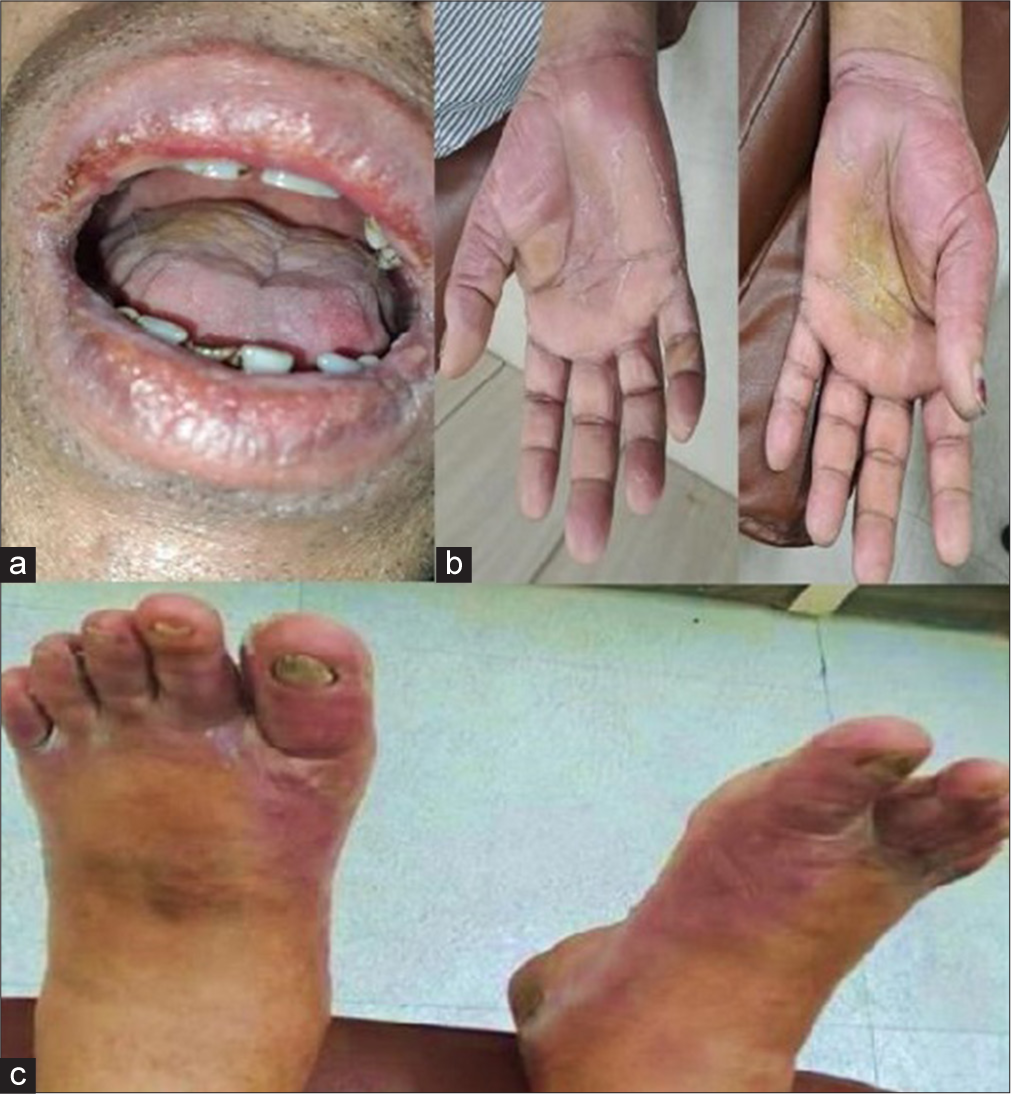Translate this page into:
Papulopurpuric Glove and Sock Syndrome: A Unique Viral Exanthem
*Corresponding author: Fiza Mohd Rafiq Choudhary, Department of Dermatology, D Y Patil Hospital, Navi Mumbai, Maharashtra, India. chaudhary.fiza@ymail.com
-
Received: ,
Accepted: ,
How to cite this article: Patil SP, Nadkarni N, Choudhary FM. Papulopurpuric Glove and Sock Syndrome: A Unique Viral Exanthem. Indian J Postgrad Dermatol. doi: 10.25259/IJPGD_101_2024
Dear Editor,
Papular purpuric glove and socks syndrome (PPGSS) is a unique viral exanthem commonly associated with viral infections. It is clinically characterised by monomorphic purpuric macules or papules with pruritic and painful oedema involving the distal extremities in a peculiar gloves and socks distribution. This case report presents a unique instance of PPGSS, emphasising the importance of recognising the syndrome and its appropriate management.
We present a case of a 54-year-old male patient, a ward boy by occupation, who came with the complaint of fever for the past 5 days, after which he developed swelling over his lower lip in addition to erosions and ulcers. Eventually, he also developed swelling and blisters over both hands and feet. A sharp erythema with demarcation is seen over the wrist and ankle as shown in Figure 1. He also complained of multiple joint pains. The patient gave no history of associated comorbidity. There is no history of drug intake before eruptions. No history of close contact suffering from a similar disease was noted.

- (a) Crusting and erosion seen over the lips. (b) Sharp demarcating erythema seen bilaterally over hands. (c) Erythema over foot.
On investigation, laboratory studies were found to be within normal limits except for elevated erythrocyte sedimentation rate which was 32 mm/h and C-reactive protein at 33 mg/dL. Parvovirus B19 serologies were positive for immunoglobulin M (IgM) and negative for immunoglobulin G antibodies. Complete blood count and liver function test were within normal limits. No further viral workup was ordered due to negative consent. Human immunodeficiency virus and hepatitis B/C, treponema pallidum hemagglutination and venereal disease research laboratory tests were negative. The histopathological finding was non-specific showing interface dermatitis with vacuolar degeneration at the dermoepidermal junction.
The patient was started on tab dexamethasone 4 mg and tab doxycycline 100 mg twice daily. Topically, the patient was started on a combination of mometasone furoate and fusidic acid cream. The lesions healed with desquamation after 2 weeks.
PPGSS was reported by Harms et al. in 1990.[1] It is a self-limiting acral dermatosis that affects children and young adults, but adult onset cases have also been reported.[2] Association between PPGSS and infection by human parvovirus B19 was made by Bagot and Revuz supporting the hypothesis of a viral aetiology.[3] The other most common presentation associated with parvovirus infection is erythema infectiosum which presents as rash having a peculiar slapped cheek appearance. Furthermore, cases can be associated with other viral infections such as Coxsackie B virus, Herpes virus 6 infection, COVID-B19 virus and drugs like trimethoprimsulfamethoxazole.[4,5] This eruption starts from acral site and may extend to non-acral sites and could also be pruritic in nature. The incubation period ranges from 10 to 13 days after infection.[5] Rash resolves within 1–2 weeks without any complication.
In our case, since there was no history of drug intake initial diagnosis of erythema multiforme was ruled out, and considering the peculiar glove and sock pattern of rash diagnosis of papulopurpuric glove and sock syndrome was considered with positive IgM. Although the literature suggests investigating other viral causes, unfortunately patient denied further investigations. Although it is a self-limiting condition, our patient was started on a short course of oral steroid and doxycycline for its anti-inflammatory and immunomodulatory effect.
The emergence of PPGSS in association with various viral infections, particularly parvovirus B19, inclines us to consider PPGSS as a differential of acute viral syndromes with associated dermatological manifestations. As we strive for early detection and management of PPGSS, healthcare providers must maintain a high index of suspicion, particularly in individuals presenting with characteristic cutaneous findings following viral illnesses. This case highlights the need for heightened awareness of PPGSS among healthcare professionals for timely recognition and to start appropriate management at a crucial time to get favourable outcomes in patients with this distinctive dermatological manifestation.
Ethical approval
Institutional Review Board approval is not required.
Declaration of patient consent
The authors certify that they have obtained all appropriate patient consent.
Conflicts of interest
There are no conflicts of interest.
Use of artificial intelligence (AI)-assisted technology for manuscript preparation
The authors confirm that there was no use of artificial intelligence (AI)-assisted technology for assisting in the writing or editing of the manuscript and no images were manipulated using AI.
Financial support and sponsorship: Nil.
References
- Papular-Purpuric “Gloves and Socks” Syndrome. J Am Acad Dermatol. 1990;23:850-4.
- [CrossRef] [PubMed] [Google Scholar]
- Adult-Onset Papular Purpuric Gloves and Socks Syndrome. Dermatol Online J. 2018;24:13030/qt02x2h6sd.
- [CrossRef] [PubMed] [Google Scholar]
- Papular-Purpuric “Gloves and Socks” Syndrome: Primary Infection With Parvovirus B19? J Am Acad Dermatol. 1991;25:341-2.
- [CrossRef] [PubMed] [Google Scholar]
- Gloves and Socks Syndrome Caused by Parvovirus B19 Infection. Dermatol Online J. 2006;12:19.
- [CrossRef] [Google Scholar]
- Febrile Illness With Skin Rashes. Infect Chemother. 2015;47:155-66.
- [CrossRef] [PubMed] [Google Scholar]






